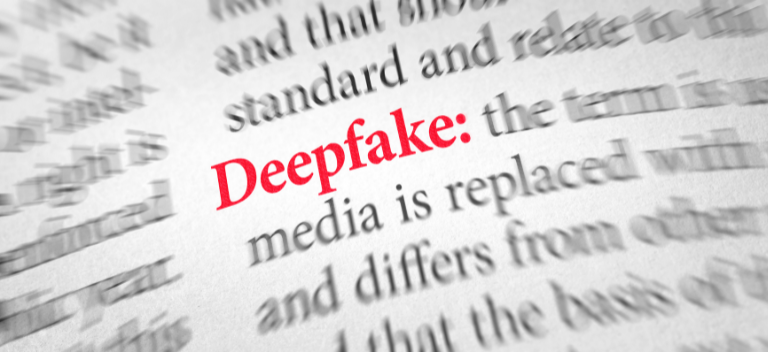
BLOG

Spotting and understanding digital impersonation through deepfakes
October is Cybersecurity Awareness Month. This year marks 20 years of the event, created as a collaborative effort between government and industry to ensure every American has the resources they need to stay safer and more secure online.
This educational article has been created to support you in spotting and understanding deepfakes.
Ever stumbled upon the term “digital impersonation?” It’s an expansive field, encompassing everything from deceptive social media profiles to manipulated videos.
Among these, deepfakes stand out as a particularly alarming player in internet risks. Not just for harmless pranks, deepfakes can be weaponized in scams, identity theft, and even international espionage.
That’s why learning to identify a deepfake transcends being a mere intriguing skill set. It emerges as an essential layer of self-defense for any individual exploring the intricate and often deceptive terrain of today’s internet.
What are deepfakes?
Simply put, deepfakes are synthetic or fabricated media created using machine learning algorithms. These algorithms are designed to produce hyper-realistic representations of real people saying or doing things they never actually said or did. By doing so, deepfakes can trick viewers, listeners, and even experts, thereby creating a distortion of reality.
The science behind deepfakes leverages neural networks, an offshoot of artificial intelligence. These algorithms can mimic anyone with enough data, such as photos, voice recordings, or videos. While there’s an undeniable “wow” factor to this, the technology also harbors the potential for misuse, notably in spreading misinformation or sowing discord.
How are they made?
In the realm of entertainment, deepfakes can replace actors in scenes or even revive deceased celebrities. Special effects teams utilize machine learning models to achieve these results.
However, deepfakes have a darker side. Imagine a manipulated video where a political leader seemingly declares war. Such deepfakes are typically created by collecting numerous images and audio clips and then using deep learning algorithms to synthesize them into a new, false context.
Creating a deepfake involves using two neural networks—generative and discriminative. The generative network produces the fake media, while the discriminative network evaluates its authenticity. They work together, essentially “teaching” each other until the generative network can produce a convincing deepfake.
Illicit examples of deepfakes
Can deepfakes cause a problem? The short answer is yes. They have the potential for far-reaching, damaging consequences.
Imagine a deepfake video portraying you committing a crime you never committed. The video goes viral before you even have a chance to defend yourself. Your reputation, painstakingly built over years, could be destroyed in mere minutes. Now extend that risk to everyone you know – family, friends, colleagues – the potential for personal life disruption is vast and scary.
Deepfakes don’t just stop at causing personal turmoil. They have the potency to wreak havoc on an entire nation’s political landscape. Imagine manipulated videos of politicians making false promises or engaging in scandalous behavior circulated widely right before an election.
This is no longer about mere mudslinging. It’s an advanced form of electoral manipulation that can misinform voters and significantly skew public sentiment. False narratives could be propagated at unprecedented scales, leading to electoral misconduct and even political instability.
In a business context, deepfakes also pose an alarming risk. Consider a fabricated video where a CEO falsely announces a corporate merger or a significant financial downturn that isn’t real. The video goes public, and before fact-checkers can catch up, the company’s stock takes a nosedive. Investors panic, pull out their funds, and the entire market fluctuates based on a lie. Not only does the targeted corporation suffer, but the ripple effect could lead to sector-wide downturns and even impact national economies.
What is the solution?
Deepfakes have moved from being a fascinating display of technology to a pressing concern that threatens our personal, political, and economic security. As these digitally manipulated videos become increasingly realistic and accessible, how do we counteract the potentially catastrophic impact of deepfakes? It requires a multi-layered approach that involves legal action, technological innovation, and collective vigilance.
Regulatory frameworks
The first line of defense against the deepfake epidemic starts in the courtroom. Laws must evolve to meet the complex challenges posed by deepfakes. Legal systems worldwide need to incorporate comprehensive penalties for the malicious creation and distribution of deepfakes.
Legislation should focus not only on the culprits behind these creations but also penalize platforms that willingly or negligently allow the distribution of such content. These laws would serve as a deterrent, signaling a zero-tolerance stance on using deceptive media to harm individuals or disrupt societal structures.
Public awareness campaigns
While laws can control the after-effects, prevention starts with education. Widespread public awareness campaigns are crucial to inform people about the existence of deepfakes and the risks associated with them. Schools, universities, and public institutions should offer seminars, workshops, and courses on digital literacy that cover the recognition of deepfakes.
Public service announcements can be aired on television and social media platforms to reach a broader audience. The ultimate goal is to arm the public with the knowledge to discern real content from manipulated media.
Advanced detection algorithms
In the ongoing battle against deepfakes, technology fights fire with fire, making it imperative for detection methods to advance at a similar pace. Several companies are developing advanced software solutions that use artificial intelligence (AI) and machine learning to detect deepfakes. These algorithms scrutinize various aspects of a media file, such as inconsistencies in lighting, facial movements, and audio, to determine its authenticity.
While not foolproof, these technologies are continually evolving to improve accuracy. Incorporating such algorithms into social media platforms and news websites can serve as an additional layer of protection against the dissemination of false information.
Community vigilance
No solution is entirely effective without community involvement. Crowdsourced reporting platforms can play a pivotal role in identifying and removing deepfakes, especially on social media. These platforms allow users to flag suspicious content for review.
With millions of eyes scrutinizing content, the chances of a deepfake going unnoticed decrease dramatically. Community vigilance complements technological solutions, adding a human element to detection efforts.
Key indicators for spotting deepfakes
As deepfakes blur the line between reality and digital fabrication, the need for discerning the genuine from the manipulated becomes increasingly urgent. Fortunately, these digital deceptions often leave behind subtle clues, such as:
- Audiovisual mismatch: Deepfakes often display incongruities between audio and visuals. A careful viewer might spot lip-syncing errors or awkward facial expressions that don’t match the tone of speech.
- Blinking anomalies: One tell-tale sign is unnatural blinking. Human blinking is subtle yet consistent, something deepfakes often fail to replicate.
- Inconsistencies in lighting and shadows: Deepfakes frequently exhibit errors in lighting and shadows, providing clues to their artificial nature.
- Pixelation and image distortions: Look for sudden blurs, pixelation, or strange distortions around facial features. These are often clues that you’re viewing a deepfake.
- Audio glitches: Static noise or unnatural modulation in voice can also indicate a deepfake.
- Metadata analysis: Although easily modified or omitted, examining the file’s metadata can offer insights into whether the file has undergone deepfake manipulations.
Expert tools for Deepfake detection
There are specialized software tools for those who want to rely on something other than human analysis. These solutions use AI algorithms to identify inconsistencies in framerate, audio, and even the direction of light and shadows.
Platforms like Deepware Scanner offer free, open-source tools for deepfake detection. These programs analyze videos frame-by-frame to ascertain their legitimacy.
There are also commercial solutions for corporate or governmental use. Businesses and governments can work with cybersecurity firms to analyze and get a detailed breakdown of potential manipulation techniques in the media file.
Conclusion
In an age where digital technologies are both awe-inspiring and potentially perilous, the rise of deepfakes underscores the importance of vigilance, education, and innovative solutions. As these sophisticated fabrications continue to challenge our perception of reality, individuals, communities, and industries must collaborate to ensure the digital realm remains trustworthy. Arm yourself with knowledge, stay updated on the latest detection methods, and remember that a discerning eye is one of the most valuable tools. Embrace the advancements, but always proceed with informed caution.
RECENT POSTS
ChattyGoblin: A new threat to iGaming and how C8 Secure can help
19 Jul, 2023
The iGaming industry is under a new threat. A malicious campaign, dubbed “ChattyGoblin,” has been targeting Southeast Asian gambling operations since October 2021.
DOWNLOAD BROCHURE
For more information, please download our solutions brochure







